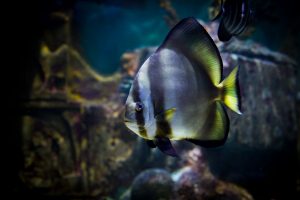
These fish were using sails way before humans even thought of them.
Distinctive thanks to their sail-like fins, Sailfin Tangs (Zebrasoma velifer) are a beautiful species that is part of the Acanthuridae family, comprising of surgeonfish, tangs and unicornfish. These tropical marine fish are generally very peaceful animals and very active swimmers, so you’ll need a keen eye to keep up with these striped creatures!
What makes the Sailfin Tang stand out?
Sailfin Tangs are disc-shaped, with a similar appearance to other surgeonfish. Its dorsal (back) and anal (underside) fins are large in size and in some cases, they can be as big as the Sailfin Tang’s body itself. As with other fish in the Acanthuridae family, the Sailfin Tang’s snout is extended, creating a distinctive appearance.
But it’s the beautiful stripes of the Sailfin Tang that really make it stand out, hence why they are a species in the Zebrasoma genus. With purple, yellow and white colouring, Sailfin Tangs also have yellow dots for added visual appearance. Other tangs are typically block colours, such as the Yellow Tang which is equally striking but is one continuous bright yellow colour. You can find both Sailfin Tangs and Yellow Tangs at Deep Sea World, giving you the chance to compare these two remarkable fish for yourself!
Sailfin Tangs have fewer pharyngeal teeth than others in the Zebrasoma group, but what teeth they do have are much larger.
The life cycle of a Sailfin Tang
It can be difficult to differentiate male from female Sailfin Tangs, but the males do perform a colour changing ritual in order to attract the females. A female Sailfin Tang will lay eggs once a month, and once hatched the larvae survive by themselves with little to no input from the parent fish.
The larvae live on the egg yolk for the first few days of its life, before moving on to plankton. As the fish mature and grow, they develop a larger oval shape and razor-like spines appear on their fins for protection. Eventually, when the Sailfin Tang is mature, their bodies become round, opaque and begin to develop that distinctive colour and pattern. In the wild, Sailfin Tang are able to live for about 5-7 years, and are primarily herbivores, feeding on microalgae and seaweed. However, some Sailfin Tang in aquaria can have a lifespan of up to 35-40 years!
They are solitary creatures and rely heavily on their surroundings for protection. Some of the most common predators of Sailfin Tang include moray eels, lionfish, reef sharks and manta rays.
Where can you find Sailfin Tang?
These striped swimmers are native to the Indian and Pacific Oceans, living amongst the reefs and lagoons off the coast of Japan, Australia and Hawaii. Sailfin tangs are commonly found in waters to a depth of between 3-200 feet, preferring areas with strong water currents and plenty of rocks and coral for hiding from predators and sleeping.
You will most likely see Sailfin Tangs swimming alone, but in some cases they’ll find a partner. While they are a peaceful species, they can sometimes be aggressive toward other Tang fish.
The different types of Tang fish
There are over 80 different types of Tang fish, and all are part of the surgeonfish family. Each type has its own striking colours and unique pattern.
Regal Tangs (Paracanthurus hepatus) are bright royal blue and canary yellow, also living in the coral reefs in the Indo-Pacific. They are similar in characteristics to Sailfin Tangs, as they also love to swim against a strong current and prefer to have hiding places in the form of rocks and coral structures.
The Yellow Tang (Zebrasoma flavescens) is also a striking species, and more commonly found in Hawaiian waters. They begin as clear larvae before developing their distinctive yellow colour, but they can also change colour depending on the time of day! At night, their colour changes from a vibrant yellow to a dark, grey-yellow with a white lateral stripe.
Sailfin Tang at Deep Sea World
You can see Sailfin Tang fish with your very own eyes at our Tropics exhibit here at Deep Sea World! With 4 tanks housing 10 different species, you’ll see these agile swimmers and more up close and personal.
Type
Fish: Solitary reef fish
What do they eat?
Algae
Size
Max 40cm
Water Type
Salt Water
Where are we?
Pacific Ocean, Indian Ocean and Red Sea

